In this edition:
- AMSAT Mail Alias Service to End August 1, 2024
- 2024 AMSAT Field Day Announcement
- GOLF Program Updates from Hamvention Forum
- AMSAT Ambassador Program Growing
- Changes to AMSAT TLE Distribution for June 7, 2024
- ARISS News
- Upcoming Satellite Operations
- Hamfests, Conventions, Maker Faires, and Other Events
- Satellite Shorts From All Over
The AMSAT News Service bulletins are a free, weekly news and information service of AMSAT, the Radio Amateur Satellite Corporation. ANS publishes news related to Amateur Radio in Space including reports on the activities of a worldwide group of Amateur Radio operators who share an active interest in designing, building, launching and communicating through analog and digital Amateur Radio satellites.
The news feed on http://www.amsat.org publishes news of Amateur Radio in Space as soon as our volunteers can post it.
Please send any amateur satellite news or reports to: ans-editor [at] amsat [dot] org.
You can sign up for free e-mail delivery of the AMSAT News Service Bulletins via the ANS List; to join this list see: https://mailman.amsat.org/postorius/lists/ans.amsat.org/
ANS-161 AMSAT News Service Weekly Bulletins
To: All RADIO AMATEURS
From: Radio Amateur Satellite Corporation
712 H Street NE, Suite 1653
Washington, DC 20002
DATE 2024 JUN 09
AMSAT Mail Alias Service to End August 1, 2024
A long standing member service, the AMSAT Mail Alias Service is scheduled to end on August 1, 2024. A mail alias on AMSAT.ORG permitted people to send an email to members without knowing their actual internet email address. They just needed to know their amateur radio callsign.
Unfortunately, the unchecked rise in domain name hacking and email account high-jacking has made it impossible to sustain this service at a cost-effective level. The number of callsign@amsat.org email accounts that had been hijacked and converted to zombie spam account over the years had led many internet service providers and gateway centers to ban all @amsat.org email addresses, including those business accounts of AMSAT officers and officials. The tireless efforts of AMSAT’s all volunteer IT staff has worked for years to repair much of the damage, but AMSAT still get complaints from members who are not getting their personal emails, ANS bulletins or AMSAT-BB posts because of persistent delivery problems.
It has come to the point where the AMSAT volunteer IT staff can no longer keep up with the maintenance requirements to keep the alias mail list clean and to work with email gateways to remove blocks. And, after considerable investigation into alternative paid email services, AMSAT leadership decided that the money required to keep an email alias system alive would be better spent on building and flying satellites for its members.
Persons using the Mail Alias Service should begin to migrate to different email accounts so they do not lose receipt of personal emails, AMSAT News Service Weekly Bulletins, AMSAT-BB posts, or official messages from AMSAT itself. Members are especially asked to make sure they are NOT using a callsign@amsat.org as their registered email address in the AMSAT membership portal. Members can easily change their registered member email address by logging into the portal and updating their profile.
[ANS thanks AMSAT for the above information.]
The 2024 AMSAT President’s Club coins are here now!
Help Support GOLF and Fox Plus
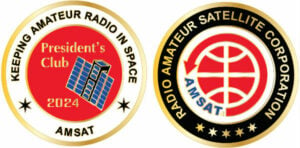
Join the AMSAT President’s Club today and help
Keep Amateur Radio in Space!
https://www.amsat.org/join-the-amsat-presidents-club/
2024 AMSAT Field Day Announcement
It’s that time of year again; summer and Field Day! Each year the American Radio Relay League (ARRL) sponsors Field Day as a “picnic, a campout, practice for emergencies, an informal contest and, most of all, FUN!” The event takes place during a 23-hour period on the fourth weekend of June. For 2024 the event takes place during a 27-hour period from 1800 UTC on Saturday June 22, 2024 through 2100 UTC on Sunday June 23, 2024. Those who set up prior to 1800 UTC on June 24 can operate only 24 hours. The Radio Amateur Satellite Corporation (AMSAT) promotes its own version of Field Day for operation via the amateur satellites, held concurrently with the ARRL event.
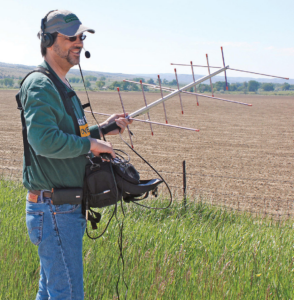
This year should be as easy as last year since we have more than 10 transponders and repeaters available. Users should check the AMSAT status page at http://www.amsat.org/status/ and the pages at https://www.amsat.org/two-way-satellites/ for what is available in the weeks leading up to field day. To reduce the amount of time to research each satellite, see the current FM satellite table at https://www.amsat.org/fm-satellite-frequency-summary/ and the current linear satellite table at https://www.amsat.org/linear-satellite-frequency-summary/
If you are considering ONLY the FM voice satellites, there are ISS, SO-50, AO-91, PO-101 and possibly LilacSat. It might be easier this year to make that one FM contact for the ARRL bonus points with so many FM birds. The congestion on FM LEO satellites is always so intense that we must continue to limit their use to one-QSO-per-FM-satellite. This includes the International Space Station. You will be allowed one QSO if the ISS is operating Voice.
It was suggested during past field days that a control station be allowed to coordinate contacts on the FM satellites. There is nothing in the rules that would prohibit this. This is nothing more than a single station working multiple QSO’s. If a station were to act as a control station and give QSO’s to every other field day station, the control station would still only be allowed to turn in one QSO per FM satellite while the other station would be able to submit one QSO.
The format for the message exchange on the ISS or other digital packet satellite is an unproto packet to the other station (3-way exchange required) with all the same information as normally exchanged for ARRL Field Day, e.g.:
W6NWG de KK5DO 2A STX
KK5DO de W6NWG QSL 5A SDG
W6NWG de KK5DO QSL
If you have worked the satellites on Field Day in recent years, you may have noticed a lot of good contacts can be made on some of the less-populated, low-earth-orbit satellites like RS-44, AO-7, or the TEVEL family. During Field Day the transponders come alive like 20 meters on a contest weekend. The good news is that the transponders on these satellites will support multiple simultaneous contacts. The bad news is that you can’t use FM, just low duty-cycle modes like SSB and CW.
THE 2024 AMSAT FIELD DAY RULES
The AMSAT Field Day 2024 event is open to all Amateur Radio operators. Amateurs are to use the exchange as specified in ARRL rules for Field Day. The AMSAT competition is to encourage the use of all amateur satellites, both analog and digital. Note that no points will be credited for any contacts beyond the ONE allowed via each single-channel FM satellite. Operators are encouraged not to make any extra contacts via theses satellites (Ex: SO-50). CW contacts and digital contacts are worth three points as outlined below.
- Analog Transponders
ARRL rules apply, except:
- Each phone, CW, and digital segment ON EACH SATELLITE TRANSPONDER is considered to be a separate band.
- CW and digital (FT-4, RTTY, PSK-31, etc.) contacts count THREE points each.
- Stations may only count one (1) completed QSO on any single channel FM satellite. If a satellite has multiple modes such as V/u and L/s modes both turned on, one contact each is allowed. If the both ISS stations are operational, one QSO on each mode (1 phone and 1 digital), Contacts with the ISS crew will count for one contact if they are active. Greencube (1 digital).
- The use of more than one transmitter at the same time on a single satellite transponder is prohibited.
- Digital Transponders
Satellite digipeat QSO’s and APRS short-message contacts are worth three points each, but must be complete verified two-way exchanges. The one contact per FM satellite is not applied to digital transponders.
The use of terrestrial gateway stations or internet gateways (i.e. EchoLink, IRLP, etc.) to uplink/downlink is not allowed.
For ‘Store and Forward’ hamsats, each satellite is considered a separate band. Do not post “CQ” messages. Simply upload ONE greeting message to each satellite and download as many greeting messages as possible from each satellite. The subject of the uploaded file should be posted as Field Day Greetings, addressed to ALL. The purpose of this portion of the competition is to demonstrate digital satellite communications to other Field Day participants and observers. Do not reply to the Field Day Greetings addressed to ALL.
The following uploads and downloads count as three-point digital contacts.
(a) Upload of a satellite Field Day Greetings file (one per satellite).
(b) Download of Satellite Field Day Greetings files posted by other stations. Downloads of non-Field Day files or messages not addressed to ALL are not to be counted for the event. Save DIR listings and message files for later “proof of contact.”
You may make contacts with GreenCube, IO-117, and each one will count as 3 points as do other digital contacts.
Please note AMSAT uploaded messages do not count for QSO points under the ARRL rules.
Sample Satellite Field Day Greetings File:
KK5DO FD EL29 class 2A 20 participants
Note that the message stated the call, operating class, where they were located (the grid square) and how many operators were in attendance.
- Operating Class
Stations operating portable and using emergency power (as per ARRL Field Day rules) are in a separate operating class from those at home connected to commercial power. On the report form simply check off Emergency or Commercial for the Power Source and be sure to specify your ARRL operating class (2A, 1C, etc.).
AND FINALLY…
The Satellite Summary Sheet should be used for submission of the AMSAT Field Day competition and be received by KK5DO (e-mail) by 11:59 P.M. CDT, Monday, July 23, 2024. This year, we are using the same due date as the ARRL. The only method for submitting your log is via e-mail to kk5do@amsat.org or kk5do@arrl.net. I have not had a mail-in entry in a very long time.
Add photographs or other interesting information that can be used in an article for the Journal.
You will receive an e-mail back (within one or two days) from me when I receive your e-mail submission. If you do not receive a confirmation message, then I have not received your submission. Try sending it again or send it to my other e-mail address.
Certificates will be awarded for the first-place emergency power/portable station at the AMSAT General Meeting and Space Symposium in the fall of 2024. Certificates will also be awarded to the second and third place portable/emergency operation in addition to the first-place home station running on emergency power. A station submitting high, award-winning scores will be requested to send in dupe sheets for analog contacts and message listings for digital downloads.
You may have multiple rig difficulties, antenna failures, computer glitches, generator disasters, tropical storms, and there may even be satellite problems, but the goal is to test your ability to operate in an emergency situation. Try different gear. Demonstrate satellite operations to hams that don’t even know the HAMSATS exist. Test your equipment. Avoid making more than ONE contact via the FM-only voice HAMSATS or the ISS, and enjoy the event!
[ANS thanks Bruce Paige, KK5DO, AMSAT Director Contests and Awards, AMSAT Board Member 2016-2024 for the above information.]
GOLF Program Updates from Hamvention Forum
For those who missed the AMSAT Forum at the 2024 Hamvention, here is an excerpt from the engineering update presented by Jerry Buxton, N0JY, AMSAT VP-Engineering about the exciting GOLF program.
Some main events happening with the GOLF program. Golf is the acronym for Greater Orbit Larger Footprint. The program is a series of satellites for flight testing and qualifications. We will be looking at testing various devices and systems that we will need as we move to HEO. Each one carries an amateur radio payload that will continue once the main testing mission is complete.
We are looking to increase orbital heights but that is getting more difficult due to the orbital debris rules. Something that we have to harness before we get out of LEO is the ability to make accurate maneuvers and collision avoidance because there is a lot of traffic up there now and hopefully, we will be able to get beyond that and ultimately our perigee is still about 2,000 kilometers that exempt us from the orbital debris rules. But the fact that we can maneuver give us the opportunity not only for deorbiting when we need to but to raise or lower our orbit to a degree so we can have a longer mission.
Speaking of longer missions, survivability is a big thing especially as we get into the Van Allen radiation belt and such. As you get further away from LEO, there is a lot more radiation bombarding you so the idea of radiation tolerance for commercial off-the-shelf (COTS) parts or in some cases when we do a HEO or a GTO we may want to use some radiation hardened parts so we get the best life out of it. So, what we’re looking at is the lowest cost versus performance. It’s a trade balance so we can keep as many satellites in space as we can successfully and return to HEO.
In order to do this, we’re going to master some satellite operations necessary for higher orbit. This doesn’t include engineering. It includes operations who will be controlling the satellites. They will need a good understanding of what the satellites will do and have good instructions to know how to control them.
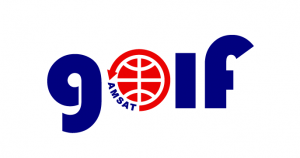
Some of the main things we need for going higher are:
Power generation. We’re going to need more gain on your power amplifiers, for example to help overcome the link budget. SDR’s can get busy and require a bit of power. There are other systems that we will want to keep running as well as experiments. Power is a premium thing that we need, that is getting power generated by the sun.
Attitude detection and control systems. ADCS something that is vital to control the satellite to point for the best sun or to maneuver. We have to be pointed very precisely if we are going to fire any thrusters. And, we need to point our microwave antennas back toward earth.
Radiation tolerance is essential to survival. In the older satellites there weren’t so many chips, the IC’s if you will, so the analog parts, the carbon resistors and such were much hardier in the radiation belt.
Microwaves – We’re going to be moving into the microwaves. 10 GHz is the ultimate downlink band. There’s a lot of bandwidth up there with 10 GHz, X-Band for downlink and 5 GHz, the C-Band for uplink.
We are also adding 2.4 GHz, S-Band uplink because that is shared with Europe and QO-100.
Thrust and propulsion will be the icing on the cake.
We have to master all of this to be responsible spacefarers.
GOLF-TEE Mission
We have Golf-Tee which stands for Technology Exploration Environment. Key features of it are:
It has deployable solar panels that we are developing inhouse. These address the need for more power.
We have secured CubeSpace ADCS, that we will use for the Attitude Detection and Control System. We were working earlier with a startup that would have given us the opportunity to fly cheaper and be part of the development but that did not come to fruition. We looked at a long list of possible ADCS systems and decided that CubeSpace would be suitable for our GOLF-TEE, GOLF-ONE and possible beyond.
We have the RT-IHU, Radiation Tolerant Internal Housekeeping Unit, which was developed as an ASCENT project using COTS, commercial-off-the-shelf, parts intended to reduce the number of upsets that cause the IHU to “latch-up” and have to re-boot. We’re going to compare that to the IHU we had on the legacy LTM, linear transponder module, used in the FOX satellites to see if, with the South Atlantic anomaly problem, if we are doing any better with resets on each of those IHU systems.
For the 10 GHz X-Band we’re going to have an experimental microwave high speed data downlink which is tricky at LEO, but as we get higher at HEO there is a lot of data we will want to download, not to mention that from experiments. It also gives us an opportunity to possibly use it as a transponder where we would pick off the downlink from the V/U transponder and send it down on 10 GHz as an entryway for people to try working with the microwave bands.
For the GOLF-Tee mission, we are looking at a 500-550 km LEO orbit, accessible through a CSLI/ELaNa launch. Its purpose is to test and qualify new technologies. It will carry the Vanderbilt/ISDE Low Energy Proton Experiment that we have flown before. This will help provide a comparison of what the environment is like with the IHU, RT-IHU and L-IHU units.
We should have a good radio footprint at 550 km. It’s orbital debris regulation “friendly” because it will decay rather rapidly with the current sunspot cycle. We’ll see how that goes because when we go will make a difference.
GOLF-1 Mission
The goals for GOLF-1 are the same as GOLF-TEE that are, hopefully, developed quite well. In the meantime, though, if there are things with the construction or during the on-orbit phases, then hopefully we will have time to make adjustments to improve on things. That’s always the way you want to go with a series of similar satellites.
This will be a typical mission versus the technology mission that GOLF-TEE is. We will carry STEM, educational based experiments. We have a high school in the San Diego area that wants to fly a camera for earth weather views. We’ll fly the Vanderbilt/ISDE Student Radiation Experiment again because there are a lot of students who like to put those together and write papers.
We’ll expand the microwave/SDR experimentation. We’ll open up the Five and Dime – that’s the 5 GHz uplink to 10 GHz downlink. Of course, at LEO it is tricky at best. Nonetheless, it will be there for experimentation with GOLF-1.
The S-Band/X-Band transponder – 2.4 GHz uplink and 10 GHz downlink (a la QO-100) – will be available.
And, we have a L-Band 1.2 GHz uplink possibility. We aren’t certain what that will be used for, perhaps commands. It’s not a worldwide band so depending on resources, we’ll probably concentrate primarily on the other bands.
Again, we’ll have a standard V/U transponder operation. However, it will be the SDR, not the LTM so it gives us the opportunity to make the transponder a variety of things such as an FM repeater or a linear transponder.
Readiness Dates
The target Readiness Date for GOLF-TEE is December 1, 2025. The Readiness Date indicates to NASA that we are ready to hand it over for integration. Integration is the activity when the satellite is put into the dispenser that then goes to the rocket. NASA holds off basically until our CDR, or Comprehensive Design Review, which will be March 2025 and looking at that readiness date in order to judge when to find a good launch for us.
The integration is typically 45 days prior to launch therefore we would not see a launch until early 2026. But it could happen that fast as they have been pretty good at lining up some launches.
For GOLF-1 the Readiness Date would be a year later, December 27, 2026. Again, we want to look at everything we can learn from GOLF-Tee and put it into GOLF-1 and make it better.
GOLF-2 and Beyond
From GOLF-2 and beyond the push for opportunities, and I say it is a good push, opportunities for higher than LEO are going to require specialized systems. We know that and is why GOLF-2 will be testing more of these systems.
The deorbit devices are just coming to commercial availability in CubeSats which is very good. They were not available until just recently. We saw at the CDW, CubeSat Developers Workshop quite a few companies with some items coming out that are helpful to us. We have a team looking at thrusters and propulsion in the ASCENT group, ASCENT meaning Advanced Satellite Communications and Exploration of New Technology.
These things can be mastered, I like to use that word, developed and mastered in LEO. We’ll be careful about what we fly so it will be a successful mission as we go for those higher and more expensive orbits.
[ANS thanks Jerry Buxton, N0JY, AMSAT VP-Engineering for the above information.]
Need new satellite antennas?
Purchase M2 LEO-Packs from the AMSAT Store.
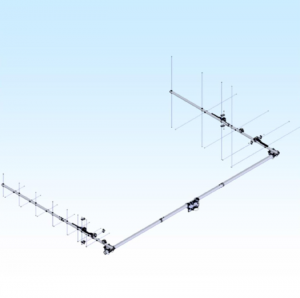
When you purchase through AMSAT, a portion of the proceeds goes towards
Keeping Amateur Radio in Space.
https://amsat.org/product-category/hardware/
AMSAT Ambassador Program Growing
A long standing service of AMSAT has been its Ambassador program designed to bring the excitement and passion to amateur radio operators through local hamfest, conventions and club meetings. One time referred to as Field Reps and at other times Local Area Coordinators, the tradition lives on, now in its recently revitalized format. Current Ambassadors have the opportunity to show off new apparel options, name badges and booth signage and display materials.
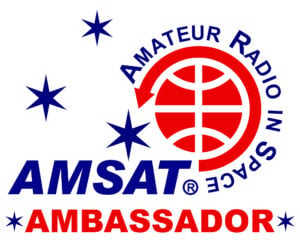
Bo Lowry, W4FCL, Director – AMSAT Ambassador Program has been tracking down previous members of the team while recruiting new members. As of this writing, the team has grown to 21 members since Hamvention 2024. Current team members include:
Mitch Ahrenstorff, AD0HJ, Jackson, MN
Barry Baines, WD4ASW, Keller, TX
Keith Baker, KB1SF, Port Huron, MI
Clint Bradford, K6LCS, Jurupa Valley, CA
Chris Brown, NY9X, Gurnee, IL
Alex Cotner, KJ6YPG, Sanger, CA
Tim Cunningham, N8DEU, Huntsville, AL
Bob Davidheiser, W5RBD, La Feria, TX
Jim DeLoach, WU0I, Sunnyvale, CA
Phillip Jenkins, N4HF, Fairaview, NC
Mark Johns, K0JM, Minneapolis, MN
Frank Karnauskas, N1UW, Tucson, AZ
Pat Kilroy, N8PK, Sykesville, MD
Frank Kostelac, N7ZEV, Las Vegas, NV
Bo Lowry, W4FCL, Louisville, KY
Chad Phillips, KG0MW, Platte, SD
Bill Rafus, KD4FRB, Weston, FL
Don Rhodes, KB2YSI, Hamilton, NY
Jim Schings, AI4SR, Lexington, KY
Tom Schuessler, N5HYP, Irving, TX
Daryl Young, K4RGK, Roswell, GA
Also, check the Upcoming Events section later in this bulletin for upcoming events that will be attended by Ambassadors.
If you are a veteran member of the team and would like to get active again, or if you would like to inquire about joining the AMSAT Ambassadors for the first time, you are encouraged to contact Bo at blowrey [at] amsat [dot]org. Or, visit https://www.amsat.org/ambassador/ for more information.
[ANS thanks Bo Lowry, W4FCL, Director – AMSAT Ambassador Program for the above information.]
Want to fly the colors on your own grid expedition?
Get your AMSAT car flag and other neat stuff from our Zazzle store!
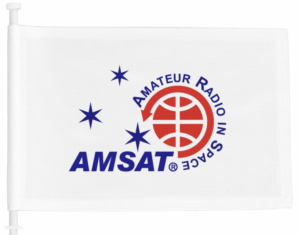
25% of the purchase price of each product goes towards
Keeping Amateur Radio in Space
https://www.zazzle.com/amsat_gear
Changes to AMSAT TLE Distribution for June 7, 2024
Two Line Elements or TLEs, often referred to as Keplerian elements or keps in the amateur community, are the inputs to the SGP4 standard mathematical model of spacecraft orbits used by most amateur tracking programs. Weekly updates are completely adequate for most amateur satellites. TLE bulletin files are updated daily in the first hour of the UTC day. New bulletin files will be posted immediately after reliable elements become available for new amateur satellites. More information may be found at https://www.amsat.org/keplerian-elements-resources/.
The following satellite has been removed from this week’s AMSAT-NA TLE distribution:
BeeSat 9 NORAD Cat ID 44412 Decayed from orbit on or about 04 June 2024
[ANS thanks Joe Fitzgerald, KM1P, AMSAT Orbital Elements Manager, for the above information.]
ARISS NEWS
Amateurs and others around the world may listen in on contacts between amateurs operating in schools and allowing students to interact with astronauts and cosmonauts aboard the International Space Station. The downlink frequency on which to listen is 145.800 MHz worldwide.

- Completed Contacts
Agrupamento de Escolas Dr. Serafim Leite, Sao Joao da Madeira, Portugal, direct via CS2ASL
The ISS callsign was OR4ISS.
The crewmember was Matthew Dominick, KC0TOR.
The ARISS mentor was Marcelo Teruel, IK0USO
Contact was successful on Thursday, June 6, 2024.
The crossband repeater continues to be active (145.990 MHz up {PL 67} & 437.800 MHz down). If any crewmember is so inclined, all they have to do is pick up the microphone, raise the volume up, and talk on the crossband repeater. So give a listen, you just never know.
The packet system is also active (145.825 MHz up & down).
As always, if there is an EVA, a docking, or an undocking; the ARISS radios are turned off as part of the safety protocol.
Note, all times are approximate. It is recommended that you do your own orbital prediction or start listening about 10 minutes before the listed time.
The latest information on the operation mode can be found at https://www.ariss.org/current-status-of-iss-stations.html
The latest list of frequencies in use can be found at https://www.ariss.org/contact-the-iss.html
[ANS thanks Charlie Sufana, AJ9N, one of the ARISS operation team mentors for the above information.]
Upcoming Satellite Operations
No operations listed.
A growing number of satellite rovers are currently engaged in sharing their grid square activations on https://hams.at. By visiting the website, you gain easy access to comprehensive information about the operators responsible for activating specific grid squares. Additionally, you have the ability to assess the match score between yourself and a particular rover for a given pass, while also being able to identify the upcoming satellite passes that are accessible from your location.
[ANS thanks Ian Parsons, K5ZM, AMSAT Rover Page Manager, and Alex Ners, K6VHF, for the above information.]
Hamfests, Conventions, Maker Faires, and Other Events
AMSAT Ambassadors provide presentations, demonstrate communicating through amateur satellites, and host information tables at club meetings, hamfests, conventions, maker faires, and other events.

- July 20, 2024
“Moon Day” Frontiers of Flight Museum
Love Field in Dallas, Texas
AMSAT volunteers needed! Contact tschuessler(at) amsat [dot] org for more information. - August 17-18, 2024
Huntsville Hamfest
Huntsville, AL
AMSAT Booth and Forum
N8DEU and W4FCL - September 7, 2024
Greater Louisville Hamfest
Shepherdsville, KY
AMSAT Forum and Information Table
W4FCL - October 5, 2024
Central Kentucky Hamfest
Lexington, KY
AMSAT and Educational Satellites Forum and Information Table
AI4SR and W4FCL
AMSAT Ambassador Clint Bradford, K6LCS, says,
“Think a 75-minute presentation on “working the easy satellites” would be appropriate for your club or event? Let me know by emailing me at k6lcsclint (at) gmail (dot) com or calling me at 909-999-SATS (7287)!”
[ANS thanks the AMSAT Events page for the above information.]
Satellite Shorts From All Over
- Warsaw University of Technology students plan to launch third satellite in 2025. The launch was originally scheduled for this year, but was delayed due to the COVID-19 pandemic. Members of the Students Space Association of the university’s Faculty of Power and Aeronautical Engineering successfully put the first Polish satellite, PW-Sat, into orbit in 2012. This feat was followed in 2018 by the launch of PW-Sat2. More information at https://tinyurl.com/ANS-161-Warsaw. [ANS thanks tvpworld.com for the above information.]
- Working around multiple helium leaks and thruster problems, the crew of Boeing’s Starliner spacecraft wrapped up a challenging rendezvous and a delayed-but-successful docking with the International Space Station Thursday in a major milestone for the new ship’s first piloted test flight. More information at https://tinyurl.com/ANS-161-Starliner. [ANS thanks spaceflightnow.com for the above information.]
- Virgin Galactic announced the completion of its second spaceflight of 2024 and 12th mission to date, carrying one researcher and three private astronauts. The ‘Galactic 07’ flight marks the Company’s seventh research mission with Virgin Galactic’s spaceship again serving as a suborbital lab for space-based scientific research. More information at https://tinyurl.com/ANS-161-Virgin. [ANS thanks Virgin Galactic for the above information.]
Join AMSAT today at https://launch.amsat.org/
In addition to regular membership, AMSAT offers membership to:
- Societies (a recognized group, clubs or organization).
- Primary and secondary school students are eligible for membership at one-half the standard yearly rate.
- Post-secondary school students enrolled in at least half time status shall be eligible for the student rate for a maximum of 6 post-secondary years in this status.
- Memberships are available for annual and lifetime terms.
Contact info [at] amsat [dot] org for additional membership information.
73 and remember to help Keep Amateur Radio in Space!
This week’s ANS Editor, Frank Karnauskas, N1UW
f.karnauskas [at] amsat [dot] org